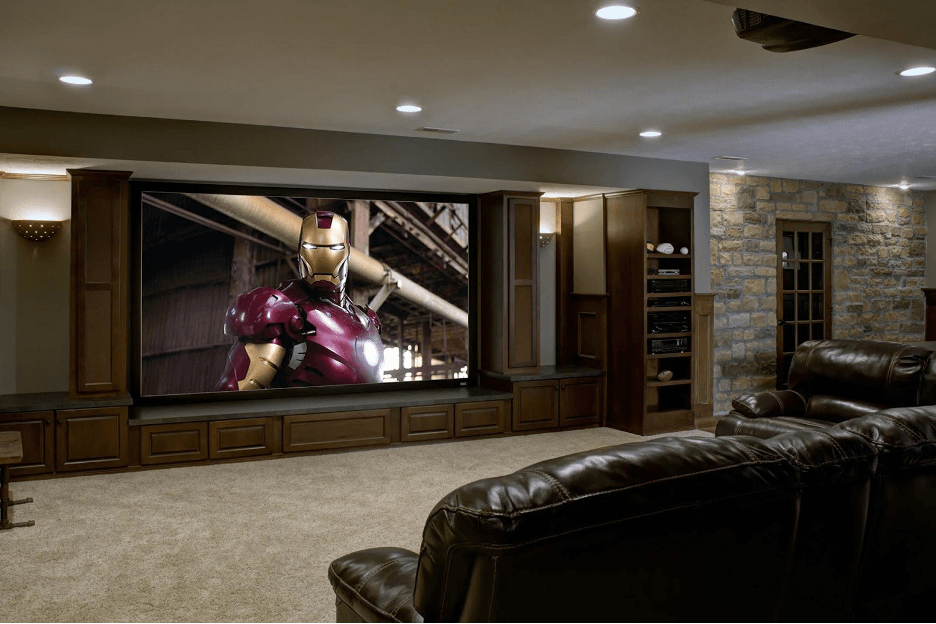Home Theater 101: Every Little Thing You Need to Know for a Motion Picture Experience at Home
Developing a home theater that matches the motion picture experience of a commercial theatre includes mindful consideration of numerous parts, including screen choice, stereo, and area layout. Each aspect plays an essential duty in achieving the desired atmosphere and performance. Whether you are pondering the perfect screen size or the ins and outs of border audio, recognizing these principles is essential. As we explore these vital elements, it ends up being obvious that the options made can dramatically influence your total watching experience, leaving one to consider exactly how these choices will certainly form your individual cinema.
Selecting the Right Screen
When establishing a home cinema, choosing the right display can make or damage the seeing experience - home theater design tampa. The display works as the centerpiece of your arrangement, affecting image top quality, seeing angles, and overall visual. Secret factors to take into consideration include display size, resolution, and kind
First, establish the suitable display dimension based on your room dimensions and seating range. Next, choose in between numerous screen types, such as fixed-frame, motorized, or retracting displays, each offering distinct advantages.
Resolution is one more essential element. For a genuinely immersive experience, take into consideration a screen developed for 4K or even 8K web content, ensuring sharpness and clearness. Furthermore, take into consideration the display's gain, which influences brightness and contrast; a higher gain can enhance illumination in well-lit areas, while a reduced gain may be extra suitable for darker environments.
Choosing Audio Equipment
Audio devices is a critical component of any home theater system, considerably improving the general viewing experience. The choice of audio gear can identify the depth, clarity, and immersion of sound, crucial for creating a cinematic ambience.
When picking audio tools, think about a surround stereo, which generally includes a receiver, multiple audio speakers, and a speaker. A 5.1 or 7.1 channel system is suggested, where the first number stands for the audio speakers and the second the speaker, supplying an immersive soundscape. The receiver is the heart of the system, handling audio and video signals, and need to sustain contemporary styles like Dolby Atmos for an enhanced spatial experience.
Quality speakers are crucial; try to find designs that provide a balanced audio profile with good bass feedback. Floor-standing audio speakers can produce richer audio, while shelf options conserve area. Additionally, take into consideration cordless options for convenience of installation, although wired systems typically provide superior performance.

Optimal Seating Plans
Developing an excellent home cinema experience pivots substantially on ideal seating plans. The arrangement of seats plays a critical function in both comfort and seeing quality, straight influencing the general cinematic experience.
First, take into consideration the display size and viewing range. A typical guideline is to place seats at a distance approximately 1.5 to 2.5 times the angled size of the screen. This makes certain an immersive experience without straining the eyes.
Following, elevation is crucial. If your seats remains in a tiered format, the back rows need to be greater than the front to avoid blockages. For flat seats, guarantee that the front row is not too near to the screen, and that every person has a clear line of vision.
Moreover, think about the arrangement in regards to social dynamics. Group seats can boost the public experience, while specific seats might be liked for personal watching.

Finally, prioritize comfort with ergonomic seats that sustains extended watching durations. Incorporating recliner chairs or supported seats can considerably boost the experience, making the home theater a favored location for both entertainment and relaxation.
Lighting and Setting
Effective illumination and atmosphere are essential elements of a properly designed home cinema, as they significantly influence the checking out experience. The appropriate lighting can enhance the cinematic feel, while bad selections can interfere with it. For optimal outcomes, take into consideration a layered illumination technique that consists of ambient, job, and accent lights.
Ambient lighting provides general illumination, guaranteeing that the area is not totally dark, which can stress the eyes. Dimmer buttons are extremely suggested, permitting changes based Full Article upon the web Extra resources content being watched. Job lights, such as wall surface sconces or flooring lights, uses useful lighting for tasks like reading or browsing the space without interfering with the overall atmosphere.
Accent lights can be made use of to highlight architectural features or develop centerpieces, adding deepness and rate of interest to the room. LED strip lights behind screens or along racks can give a subtle glow that boosts the visual experience without frustrating the customer.

Wiring and Installation Tips
A well-planned wiring arrangement is critical for attaining ideal performance in your home cinema system. Appropriate electrical wiring not only ensures high-quality sound and video signals but additionally improves the general aesthetic of your room. Begin by drawing up your layout, identifying where each part will be positioned, click over here including your display, speakers, and receiver.
When picking cords, focus on high-grade, properly evaluated circuitry to minimize signal loss. HDMI cable televisions should be made use of for video links, while speaker cord must match the specifications of your audio speakers and amplifier. Choose in-wall ranked cable televisions to abide by security standards and preserve a clean look.

Verdict
In summary, developing an extraordinary home cinema experience calls for careful consideration of various aspects, including screen option, audio equipment, seating plans, lighting, and circuitry. Each element plays a crucial function in attaining optimal performance and setting, ultimately improving the satisfaction of home entertainment. By prioritizing these aspects, a motion picture atmosphere can be effectively reproduced, permitting immersive seeing experiences that equal typical theater settings. Interest to information in each location is essential for general fulfillment.
Creating a home theater that rivals the motion picture experience of a commercial theater entails mindful factor to consider of several elements, including screen selection, sound systems, and area design.When setting up a home theater, selecting the right display can make or damage the viewing experience. Next off, pick between various display types, such as fixed-frame, motorized, or retracting displays, each offering unique advantages. For a truly immersive experience, consider a display created for 4K or even 8K content, ensuring intensity and clearness.In summary, developing a phenomenal home movie theater experience needs careful factor to consider of different elements, consisting of screen option, audio devices, seating arrangements, lights, and electrical wiring.